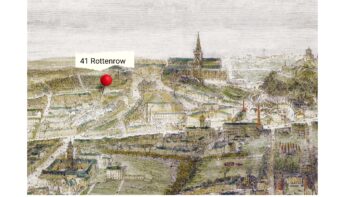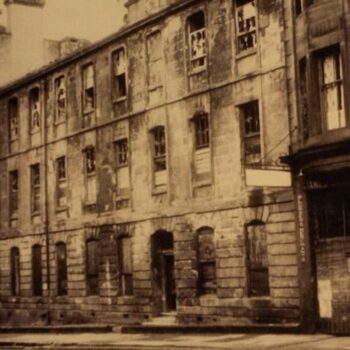By Anna Forrest
No. 41 ROTTENROW
The building at No. 41 Rottenrow was the Glasgow Lock Hospital for Unfortunate Females. The name “Lock” comes from the Old English “loke” for a leper house. The first Lock Hospital in Britain was established in London and built on the site of a former leper house.
The female inmates of the Lock Hospital were not locked in or restrained. This was Glasgow’s first and only provision for women afflicted by venereal disease, believed to be the penalty for their evil ways. Glasgow’s population had exploded in these years with Irish immigrants and those displaced from the Highland areas, fleeing famine and poverty. There were also numbers of military preparing for and retuning from combat abroad, carrying their own injuries and diseases. These were also the typhus and cholera years.

TREATMENT, KNOWLEDGE, REFORMATION
The new, purpose-built Lock Hospital at No 41 opened its doors in 1845-46 and was overwhelmed by numbers of diseased females whose only other recourse was to die in the streets and slums of this squalid area. The building had 7 wards with provision for 80 beds and medical staff mainly living in.
The legend over the entrance read “Treatment, Knowledge, Reformation”, and a most curious thing, it was built to look like a tenement, sitting with the many verminous tenements that surrounded it. Rottenrow with its many wynds and vennels, was the least salubrious part of Glasgow. Brothels and shebeens abounded in the tenements serving the music halls, variety theatres and attractions of every kind.

THE FIRST TEN YEARS
The Lock’s Annual Report for the first 10 years of it’s services indicates thousands of women and young girls, abandoned and desperate, applying for shelter and treatment. They are listed as mill girls, domestic servants, widows, actresses or ballet girls, and sadly, schoolgirls. They were cited in their diseased state by codewords and terms such as ‘newly fallen’ or ‘hardened’.
Many came from nearby establishments such as The Magdalene Asylum for Fallen Women and Girls and from the Police Courts via Duke Street Jail. Once arrested, they would be stripped and examined and if signs of syphilis were obvious, then manacled and marched to the Lock for treatment. This would be a terrifying ordeal as it was common knowledge that few survived the Lock. These measures were designed to control the behaviour of poor and vulnerable women.
REFORMATORY CONDITIONS
Although not legally restrained, the women were kept in reformatory conditions. Admissions had their heads shaved, were deloused and disinfected with 3% carbolic solution. They wore regulation brown drawers and smocks, and worked in the basement laundry and mortuary. Average stay in the Lock was 29 nights. Diet was basic, porridge, milk, bread and broth, and small beer.
The medical treatments were more experimental than effective. Preparations such as, ointments, pills, salivations, poultices and mercury vapour baths were used. Horrific though it appeared, regular food and shelter were often preferred to dying on filthy streets. Weathy, middle-class and respectable women were treated privately at home by their physicians.
From the earliest times finding cures for these diseases were rudimentary and superstition-ridden. Any effective treatments would ultimately be used for the benefit of men, the unfortunate recipients of conditions caused and spread by women. At this time fighting forces were of paramount importance. Barracks and garrisons opened their own hospitals only for the treatment of men. Ports and cities, such as Glasgow, operated police controls for the apprehension and detention of known prostitutes and women on the streets with no visible means of support. The closing and control of brothels and other draconian measures were enforced to curb a condition which was reaching epidemic proportions.
The Lock established classes given by worthy wives and mothers in Christian instruction and domestic duties to give the female inmates a glimpse of decency and cleanliness. Social Hygiene Committees, Lady Child Savers, Street Mission work and charities abounded in these years, working to clear the Second City of the Empire of squalor and sin.
Anna Forrest has carried out extensive research on the Glasgow Lock Hospital. Her interest began whilst she was working as a Librarian at the Royal College of Physicians and Surgeons of Glasgow, which features a ‘Lock Room’ containing records relating to the hospital. Over many years Anna pieced together the history of the hospital, which she had originally been told didn’t exist, with the aim of making sure the public knew the stories of the women and girls treated there.
WANT TO KNOW MORE?
- Our Gallus Glasgow animation follows a day in the life of Elizabeth and her family in 1864, the year Sulman created his ‘Bird’s Eye View’ of the city. Working as a domestic in the West End, Elizabeth has heard stories of girls sacked for minor misdemeanours who have then ended up in the Lock. Read her story here.
- Check out our Gallus Glasgow map and explore more stories of the Victorian city. Once there, why not add a few stories of your own?
- Prints of the map are available to buy in our online shop



